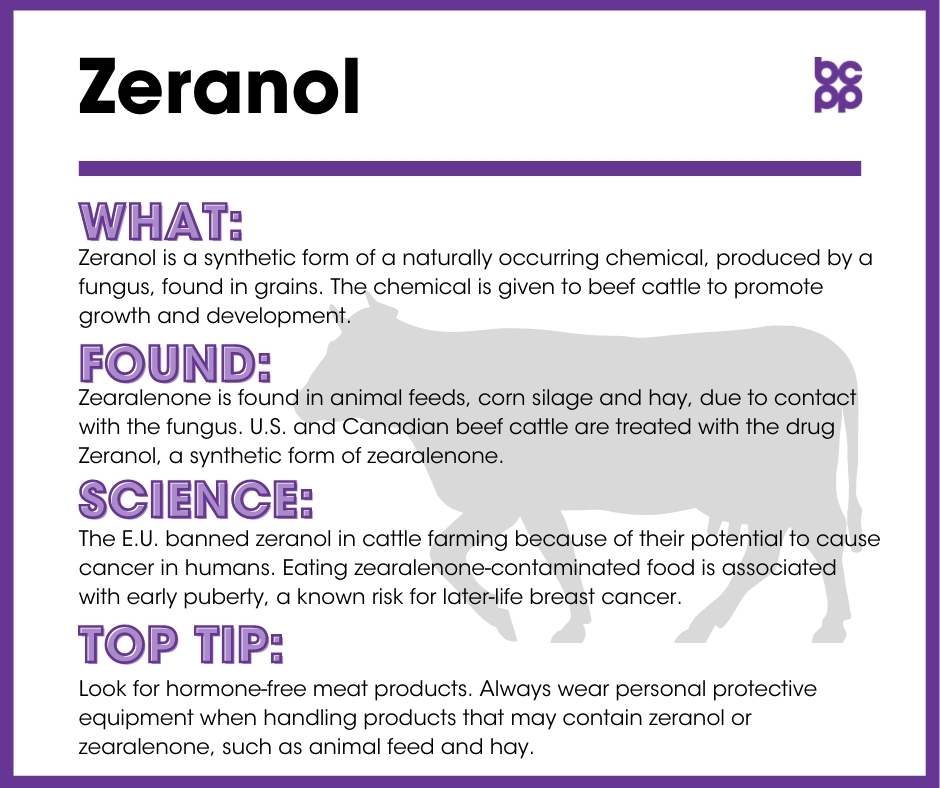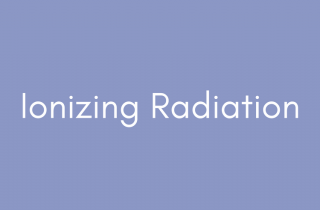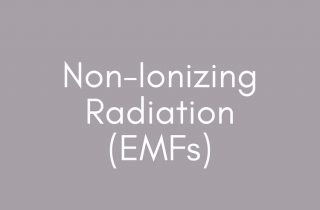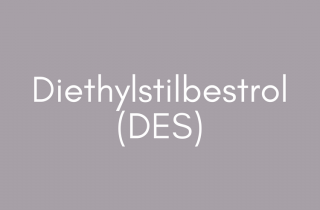Zeranol and Mycoestrogens
At a Glance
Mycoestrogens are naturally occurring endocrine disruptors found primarily in grains.
Certain mycoestrogens, including especially zearalenone, may advance the growth of breast cancer cells. An important metabolite (breakdown product) of zearalenone is zeranol, a compound that is also produced as a synthetic compound (brand name Ralgro) and is largely used in the U.S. beef industry to increase growing speeds of the animals used for meat.
Zearalenone and zeranol mimic the natural estrogen estradiol. Both compounds can stimulate growth and proliferation of human breast tumor cells in vitro at potencies similar to the effects of estradiol.
What are zeranol and mycoestrogens?
Zeranol is a synthetic version of zearalenone, a natural chemical that is produced by the fungus Fusarium.[1],[2] In vitro, zeranol stimulates growth and replication of human breast tumor cells that are sensitive to estrogen at rates similar to those induced by the natural hormone estradiol and the known carcinogen diethylstilbestrol (DES).[3]
In 1981 the European Union banned the use of zeranol and other growth promoters in cattle farming because of their potential to cause cancer in humans, and in 1989 the European Union prohibited the import of beef products from the United States or Canada that use zeranol as a growth promoter.[4][5]
Where are zeranol and zearalenone found?
The natural compound zearalenone is found in animal feeds, corn silage and also hay, due to contact with the fungus Fusarium.[6],[7] Zearalenone can be found in many agricultural products, including cereals, mixed feeds and rice. It may also be found in meat, eggs, dairy and other products from animals that have consumed the contaminated feed.[8],[9] Corn is the most commonly contaminated crop, and high levels of zearalenone have been found in girls who consume higher levels of popcorn.[10],[11],[12] Zeranol is found in the meat of U.S. and Canadian beef cattle treated with the drug. Studies have shown the potentially damaging effects on abnormal cell growth to be significant even at levels of zeranol that are almost 30 times lower than the then-current FDA-established limit in beef of 150 parts per billion.[13],[14]
What evidence links zeranol and mycoestrogens to breast cancer?
Contamination of food by zearalenone has been associated with early pubertal development, which is a known risk factor for later-life breast cancer.[15],[16],[17] Zearalenone and its metabolites have been shown to stimulate proliferation of estrogen-receptor-positive breast cancer tumor cells in vitro.[18]
Studies have shown that zeranol is comparable to the natural estrogen estradiol in its ability to transform normal human breast cells into cells showing signs of early cancer development.[19],[20],[21],[22] Some studies showed that adding zeranol to cultured breast epithelial cells resulted in a five-fold increase in volume compared to non-zeranol-treated control cells.[23] Preliminary data indicate that serum (blood plasma) from zeranol-treated beef cattle can stimulate the proliferation of normal breast epithelial cells and the transformation of breast tumor cells in vitro.[24],[25]
Puberty onset was earlier among pre-pubertal mice or rats exposed to either zearalenone or zeranol.[26],[27] Treatment of young female mice with zeranol led to earlier maturation of the mammary gland,[28] which may be linked to increased risk of mammary gland tumors later in life.[29]
Mycoestrogens disrupt levels of hormones such as estrogen in the body.[30],[31]
- Fusarin C infects cereal kernels and has been linked to increased growth and proliferation of breast cancer cells.[32]
- Zearalenone can contaminate corn, wheat, oats, hay and other animal feed crops.[33] It has been linked to early puberty in girls, which is a risk factor for breast cancer.[34]
- Zearalenone and α-Zearalenol were shown to cause proliferation of certain breast cancer cells.[35]
- When fetal and neonatal rats were exposed to low doses of zearalenone, mammary gland development was abnormal and the rats had an increased risk of developing mammary tumors.[36]
- High dietary exposure to mycoestrogens in dogs resulted in an increase in the number of mammary tumors.[37]
Who is most likely to be exposed to zeranol, zearalenone or mycoestrogens?
- Individuals who eat beef raised in the United States and Canada, since zeranol may be present in some beef.
- Individuals who come into contact with agricultural or livestock products such as animal feed and hay.
- Farm workers who work in the corn, rice or cereal industries.
- Any individual who eats grains and meat may be exposed to products contaminated with zearalenone or mycoestrogens.[38],[39]
Who is most vulnerable to the health effects of zeranol and mycoestrogens?
- Young girls are especially vulnerable to the health effects of zeranol, due to concerns about links between early puberty and later-life breast cancer.[40],[41]
- Cell growth, proliferation and sensitivity to the negative effects of environmental exposures are all increased during pregnancy. Thus exposure to zeranol during pregnancy may contribute to increased risks of pregnancy-related breast cancer.[42]
- Anyone may be exposed to mycoestrogens. The amount of exposure determines the health effects.[43]
What are the top tips to avoid exposure?
- Look for hormone-free meat products.
- Always wear personal protective equipment when handling products that may contain zeranol or zearalenone, such as animal feed and hay.
- If possible, limit intake of foods such as popcorn and other grains that may contain mycoestrogens.
Reviewed 2019
[2] Mirocha, CJ et al. “Incidence of zearalenol (Fusarium mycotoxin) in animal feed.” Applied and Environmental Microbiology 38 (1979): 749–750. doi:10.1128/aem.38.4.749-750.1979.
[3] Leffers, H et al. “Oestrogenic potencies of Zeranol, oestradiol, diethylstilboestrol, Bisphenol-A and genistein: implications for exposure assessment of potential endocrine disrupters.” Human Reproduction 16, 5 (2001): 1037-45. doi:10.1093/humrep/16.5.1037.
[4] Updike, Michael Scott et al. “Primary cultured human breast epithelial cells up-regulate protein disulfide isomerase in response to zeranol.” Anticancer Research 27, 1A (2007): 407-10.
[5] Johnson, Renée. “The U.S.-EU Beef Hormone Dispute”. Congressional Research Service. January 14, 2015. https://www.fas.org/sgp/crs/row/R40449.pdf.
[6] Benzoni, E et al. “Influence of in vitro exposure to mycotoxin zearalenone and its derivatives on swine sperm quality.” Reproductive Toxicology 25, 4 (2008): 461-7. doi:10.1016/j.reprotox.2008.04.009.
[7] Mirocha, CJ et al. “Incidence of zearalenol (Fusarium mycotoxin) in animal feed.” Applied and Environmental Microbiology 38 (1979): 749–750. doi:10.1128/aem.38.4.749-750.1979.
[8] Benzoni, E et al. “Influence of in vitro exposure to mycotoxin zearalenone and its derivatives on swine sperm quality.” Reproductive Toxicology 25, 4 (2008): 461-7. doi:10.1016/j.reprotox.2008.04.009.
[9] Bandera, Elisa V et al. “Urinary mycoestrogens, body size and breast development in New Jersey girls.” The Science of the Total Environment 409, 24 (2011): 5221-7. doi:10.1016/j.scitotenv.2011.09.029.
[10] Updike, Michael Scott et al. “Primary cultured human breast epithelial cells up-regulate protein disulfide isomerase in response to zeranol.” Anticancer Research 27, 1A (2007): 407-10.
[11] Khosrokhavar, Roya et al. “Effects of zearalenone and alpha-Zearalenol in comparison with Raloxifene on T47D cells.” Toxicology Mechanisms and Methods 19, 3 (2009): 246-50. doi:10.1080/15376510802455347.
[12] Bandera, Elisa V et al. “Urinary mycoestrogens, body size and breast development in New Jersey girls.” The Science of the Total Environment 409, 24 (2011): 5221-7. doi:10.1016/j.scitotenv.2011.09.029.
[13] “Title 21–Food and Drugs, Chapter I–Food and Drug Administration, Department of Health and Human Services, Subchapter E – Animal Drugs, Feeds, and Related Products, Part 522 — Implantation of Injectable Dosage Form New Animal Drugs, Sec. 522.2680 Zeranol.” Code of Federal Regulations, Sec. 522.2680 (2019). http://www.accessdata.fda.gov/scripts/cdrh/cfdocs/cfcfr/CFRSearch.cfm?fr=522.2680.
[14] Liu, Suling et al. “Involvement of breast epithelial-stromal interactions in the regulation of protein tyrosine phosphatase-gamma (PTPgamma) mRNA expression by estrogenically active agents.” Breast Cancer Research and Treatment 71, 1 (2002): 21-35. doi:10.1023/a:1013343718942.
[15] Massart, Francesco et al. “High growth rate of girls with precocious puberty exposed to estrogenic mycotoxins.” The Journal of Pediatrics 152, 5 (2008): 690-5, 695.e1. doi:10.1016/j.jpeds.2007.10.020.
[16] Clavel-Chapelon, F, and E3N-EPIC Group. “Differential effects of reproductive factors on the risk of pre- and postmenopausal breast cancer. Results from a large cohort of French women.” British Journal of Cancer 86, 5 (2002): 723-7. doi:10.1038/sj.bjc.6600124.
[17] Anderson, William F et al. “Estimating age-specific breast cancer risks: a descriptive tool to identify age interactions.” Cancer Causes & Control 18, 4 (2007): 439-47. doi:10.1007/s10552-006-0092-9.
[18] Khosrokhavar, Roya et al. “Effects of zearalenone and alpha-Zearalenol in comparison with Raloxifene on T47D cells.” Toxicology Mechanisms and Methods 19, 3 (2009): 246-50. doi:10.1080/15376510802455347.
[19] Liu, Suling, and Young C Lin. “Transformation of MCF-10A human breast epithelial cells by zeranol and estradiol-17beta.” The Breast Journal 10, 6 (2004): 514-21. doi:10.1111/j.1075-122X.2004.21410.x.
[20] Leffers, H et al. “Oestrogenic potencies of Zeranol, oestradiol, diethylstilboestrol, Bisphenol-A and genistein: implications for exposure assessment of potential endocrine disrupters.” Human Reproduction 16, 5 (2001): 1037-45. doi:10.1093/humrep/16.5.1037.
[21] Ye, Weiping et al. “In vitro transformation of MCF-10A cells by sera harvested from heifers two months post-Zeranol implantation.” International Journal of Oncology 38, 4 (2011): 985-92. doi:10.3892/ijo.2011.941.
[22] Ye, Weiping et al. “Zeranol enhances the proliferation of pre-adipocytes in beef heifers.” Anticancer Research 29, 12 (2009): 5045-52.
[23] Updike, Michael Scott et al. “Primary cultured human breast epithelial cells up-regulate protein disulfide isomerase in response to zeranol.” Anticancer Research 27, 1A (2007): 407-10.
[24] Ye, Weiping et al. “In vitro transformation of MCF-10A cells by sera harvested from heifers two months post-Zeranol implantation.” International Journal of Oncology 38, 4 (2011): 985-92. doi:10.3892/ijo.2011.941.
[25] Ye, Weiping et al. “Zeranol enhances the proliferation of pre-adipocytes in beef heifers.” Anticancer Research 29, 12 (2009): 5045-52.
[26] Yuri, Takashi et al. “Effects of prepubertal zeranol exposure on estrogen target organs and N-methyl-N-nitrosourea-induced mammary tumorigenesis in female Sprague-Dawley rats.” In Vivo 18, 6 (2004): 755-61.
[27] Nikaido, Yasuyoshi et al. “Effects of prepubertal exposure to xenoestrogen on development of estrogen target organs in female CD-1 mice.” In Vivo 19, 3 (2005): 487-94.
[28] Sheffield, L G, and C W Welsch. “Zeranol (beta-resorcylic acid lactone), a common residous component of natural foodstuffs, stimulates developmental growth of the mouse mammary gland.” Cancer Letters 28, 1 (1985): 77-83. doi:10.1016/0304-3835(85)90095-3.
[29] Moral, Raquel et al. “Effect of prenatal exposure to the endocrine disruptor bisphenol A on mammary gland morphology and gene expression signature.” The Journal of Endocrinology 196, 1 (2008): 101-12. doi:10.1677/JOE-07-0056.
[30] Benzoni, E et al. “Influence of in vitro exposure to mycotoxin zearalenone and its derivatives on swine sperm quality.” Reproductive Toxicology 25, 4 (2008): 461-7. doi:10.1016/j.reprotox.2008.04.009.
[31] Bandera, Elisa V et al. “Urinary mycoestrogens, body size and breast development in New Jersey girls.” The Science of the Total Environment 409, 24 (2011): 5221-7. doi:10.1016/j.scitotenv.2011.09.029.
[32] Sondergaard, T. E. et al. “Fusarin C acts like an estrogenic agonist and stimulates breast cancer cells in vitro.” Toxicology Letters 205, 2 (2011): 116–121. doi:10.1016/j.toxlet.2011.05.1029.
[33] Benzoni, E et al. “Influence of in vitro exposure to mycotoxin zearalenone and its derivatives on swine sperm quality.” Reproductive Toxicology 25, 4 (2008): 461-7. doi:10.1016/j.reprotox.2008.04.009.
[34] Massart, Francesco et al. “High growth rate of girls with precocious puberty exposed to estrogenic mycotoxins.” The Journal of Pediatrics 152, 5 (2008): 690-5, 695.e1. doi:10.1016/j.jpeds.2007.10.020.
[35] Khosrokhavar, Roya et al. “Effects of zearalenone and alpha-Zearalenol in comparison with Raloxifene on T47D cells.” Toxicology Mechanisms and Methods 19, 3 (2009): 246-50. doi:10.1080/15376510802455347.
[36] Belli, Patrick et al. “Fetal and neonatal exposure to the mycotoxin zearalenone induces phenotypic alterations in adult rat mammary gland.” Food and Chemical Toxicology 48, 10 (2010): 2818-26. doi:10.1016/j.fct.2010.07.012.
[37] Frehse, M S et al. “Aflatoxins ingestion and canine mammary tumors: There is an association?.” Food and Chemical Toxicology 84 (2015): 74-8. doi:10.1016/j.fct.2015.08.004.
[38] Mukherjee, Dwaipayan et al. “Physiologically-based toxicokinetic modeling of zearalenone and its metabolites: application to the Jersey girl study.” PloS One 9,12 (2014): e113632. doi:10.1371/journal.pone.0113632.
[39] Bandera, Elisa V et al. “Urinary mycoestrogens, body size and breast development in New Jersey girls.” The Science of the Total Environment 409, 24 (2011): 5221-7. doi:10.1016/j.scitotenv.2011.09.029.
[40] Clavel-Chapelon, F, and E3N-EPIC Group. “Differential effects of reproductive factors on the risk of pre- and postmenopausal breast cancer. Results from a large cohort of French women.” British Journal of Cancer 86, 5 (2002): 723-7. doi:10.1038/sj.bjc.6600124.
[41] Anderson, William F et al. “Estimating age-specific breast cancer risks: a descriptive tool to identify age interactions.” Cancer Causes & Control 18, 4 (2007): 439-47. doi:10.1007/s10552-006-0092-9.
[42] Andersson, Therese M-L et al. “Increasing incidence of pregnancy-associated breast cancer in Sweden.” Obstetrics and Gynecology 114, 3 (2009): 568-72. doi:10.1097/AOG.0b013e3181b19154.
[43] Khosrokhavar, Roya et al. “Effects of zearalenone and alpha-Zearalenol in comparison with Raloxifene on T47D cells.” Toxicology Mechanisms and Methods 19, 3 (2009): 246-50. doi:10.1080/15376510802455347.






